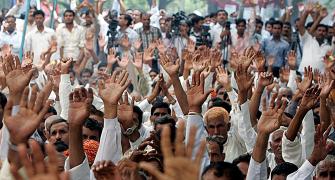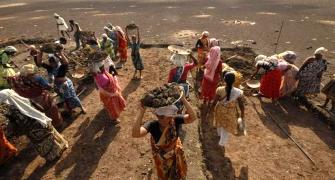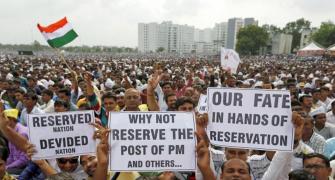'As soon as the BJP feels they are going to lose power, they will publish the caste census data of 2011 and conduct the caste census of 2021.'

In 2018, when the Narendra Damodardas Modi government introduced Article 342A through the 102nd Constitutional Amendment that empowered the President to specify the socially and educationally backward communities in a state, the Opposition feared that it would lead to state governments losing the power to finalise their own Other Backward Caste lists.
The Supreme Court of India recently quashed the Maharashtra government's decision to grant reservations to the Maratha community, saying as per Article 342A only the Centre was empowered to draw up a central OBC list.
Justice V Eswaraiah is former acting chief justice of the Andhra Pradesh high court, former chairperson of the National Commission for Backward Classes, president, All India BC Federation and convenor, Social Revolution Alliance.
"Once the caste data is published, every community will get its due share," Justice Eswaraiah tells Syed Firdaus Ashraf/Rediff.com.
The Congress is accusing the Bharatiya Janata Party-led central government of assaulting India's federal structure by taking away the states' power to identify the list of backward classes. Is there any truth in these allegations?
There is a difference of opinion in so far as the identification of Other Backward Classes, ie, Socially and Educationally Backward Classes are concerned.
We have a long history about the backward classes in our country.
The backward classes (category) comes under Article 16(4) of the Constitution of India, which states 'Nothing in this Article shall prevent the state from making any provision for the reservation of appointments or posts in favour of any backward class of citizens which, in the opinion of the state, is not adequately represented in the services under the state.'
Now, the question arises: Who are the backward classes?
In the case of Indra Swahney vs Union of India (1992) SUPP (3) SCC 217, (Mandal Case) the Supreme Court explained the meaning of backward classes under Article 16(4) of the Constitution of India.
Backward Classes means Socially and Educationally Backward Classes (OBCs), Untouchables (Scheduled Castes) and Adivasis (Scheduled Tribes).
The other backward classes -- the Socially and educationally backward classes -- are classified/identified under Article 340 (external link) in the Constitution of India.
Do you mean that till 1993, after 46 years of Independence, the government had not identified other socially and educationally backward classes?
Yes, the Government of India has not identified the Socially and Educationally Backward Classes from 1950 till 1993 till the date the Mandal Commission report was accepted and implemented for providing 27 per cent reservations in the central government services and central government public sector undertakings.
The first commission that was appointed (for this purpose) was headed by Kaka Kalelkar (1953) and the second such commission was the Mandal Commission of 1979, headed by B P Mandal.
His commission investigated the conditions of the socially and educationally backward classes in the whole of India and the difficulties under which they laboured and made recommendations to take appropriate steps to remove such difficulties and improve their conditions and make the grants.
The weightage given in identifying the SEBCs are three points for social, two points for education and one point for economic.
If you see the history of post-Independence India, Backward Classes had to be identified under Article 340. But unfortunately, they were not.
Unlike them, the Scheduled Castes and Scheduled Tribes were identified during British rule and were later given recognition under the Indian Constitution (too).
After Independence, different state governments started mounting pressure on the Centre for identification of Socially and Educationally Backward Classes for the purpose of providing them reservations in the education and employment (services).
There were no honest and sincere efforts to identify the OBCs (SEBCs) for providing reservations to other Backward Classes by successive governments from 1950 onwards.
As the Government of India failed to identify the SEBCs, the states sought power to do so on their own. They wrote to the Centre in this regard.
In which year and which state?
Prior to Independence, reservations were provided in the state of Madras Presidency and Kerala state. The reservations were first implemented by Shahu Maharaj and the Mysore king. In Madras presidency, reservations were being implemented from 1927 onwards.
The central government took a decision that no all India list of backward classes should be drawn up nor any reservations in the central government services for backward classes other than the SCs and STs.
Consequently, on August 14 1961, the ministry of home affairs addressed all the state governments giving them discretion to choose their own criteria for defining the backward classes
The central government permitted the respective states to appoint their state level commissions to identify the OBCs for providing reservations for the other Backward Classes in state government services and state educational institutions.
This could happen only because of Article 15(4) added to the Constitution of India in 1951 and Article 16(4), which allowed states to 'create special arrangements for promoting the interests and welfare of socially and educationally Backward Classes of the society in their states and to provide adequate representation in the services of the state'.
Sadly, this situation came because of the Savarna communal politics around reservations.
Before Independence there were communal reservations for Muslims, Christians, Anglo-Indians, Brahmins and Non-Hindu Brahmins etc, in Madras state given since 1927 onwards.
This continued after Independence.
But this was challenged in the Madras high court in the famous Champakam Dorairajan vs State of Madras (1951) in which the state lost.
The decision was upheld by the Supreme Court.
At that time, Dr B R Ambedkar was the law minister of India. He felt very bad about this judgment. He felt without reservations, how could he help the Other Backward Classes?
Thus, the Constitution was amended in 1951 by including Article 15(4).
This was one of the first Constitutional amendments.
The first amendment (extrenal link) and Article 16(4) empowered the states to undertake affirmative action for the advancement of any socially and economically backward classes category-wise and for providing adequate representations in the state services.
And even after that, for the next 14 years, nothing was done for the welfare of backward classes.
The Kalelkar Commission report was not accepted.
Ultimately, since the central government failed to identify the socially and educationally backward classes, in 1969, Andhra Pradesh set up its own commission called the Anantharaman Commission for identification of the OBCs.
This commission identified other backward classes category-wise in the state of undivided Andhra Pradesh.
Many states appointed their own commissions and identified the OBCs and in 11 states OBCs are categorised.
Although, in North India, not many states followed this reservation system at that time.
How does Tamil Nadu provide 69 per cent reservations while the Supreme Court clearly stated in its 1992 judgment in the Indra Sawhney vs Union of India case that reservations cannot exceed 50 per cent?
The Supreme Court did not disturb the existing reservations of Tamil Nadu state which crossed 50 per cent of upper cap in the case of Indra Sawhney vs Union of India.
In 1993, the then chief minister of Tamil Nadu state, with the help of the then prime minister, got their State Act 1993 providing reservations of 50 per cent for OBCs, 18 per cent for SCs and 1 per cent for STs, included in the 9th Schedule of the Constitution.
They cited special circumstances as a reason for doing this.
Today the OBC population is 45 per cent of India's total population...
(Interrupts) It is not 45 per cent, but it is much more than 52 per cent, as per the Mandal Commission report and 1931 castes census.
But the school enrolment data that came out recently states that India has 45 per cent OBC population.
That is only sample survey data. This survey cannot be true.
But the number of backward classes is increasing day by day. If I am not mistaken, during Mandal times there were 3,743 castes identified as OBCs and today that number has risen to 5,013. How did that happen?
The state governments based on their state commissions used to go on adding more number of castes to their states OBCs list and used to demand the NCBC to add them in the central OBCs list.
Thus, many more castes were included from 1993 till I left the Commission in 2016 without exclusion of any castes.
The government has provided additional 10 per cent reservations for the economically weaker sections for the upper castes excluding the poor SCs, STs and OBCs.
If they wanted that, they should have given the EWS quota to the poorest people of all castes and communities of India below the poverty line, but they did not do that.
Instead, they gave it to people whose annual income is less than Rs 8 lakh, having not more than 5 acres of agriculture land, residential flat below 1000 feet, for the population of 5 per cent of EWS giving 10 per cent reservations to them.
Why is the Modi government not releasing the OBC caste census data?
From 1871 to 1931, the British government did the caste census seven times. They could not do it in 1941 due to World War II.
After Independence, it was decided in Parliament (in 2010) to have socio-economic caste census and for the first time, the central government conducted the socio-economic caste census of 2011 and completed in 2014.
For six months, the then Congress government did not release the data and the Modi government too has not released it for the past seven years.
The Modi government wants to hide the truth about the caste census data.
Apney sach ko chupana chahte hain (they want to hide the truth)<?em>.
Once this data is public, there will be a huge backlash. People will fight for their due share and rights in all the three wings of the government.
The undue share of the upper classes -- specifically the Savarnas -- being enjoyed in the legislature, executive, administration, judiciary, etc, would like to be kept in secret or to hide the truth.
What is the quantum of their share in all three wings for the upper caste population and what is the quantum of share being enjoyed by SCs, STs and OBCs and minorities is being suppressed and the truth is hidden by not publishing the socio-economic caste census 2011 and by not conducting the socio-economic caste census of all caste communities in 2021.
The government would like to suppress the truth to be known -- that what is the ratio of upper caste people occupying the posts and services such as IAS, IPS, legislators, members of Parliament, ministers, judges, administrators, executives, industrialist, media owners etc.
The Constitution was never properly implemented and till today justice, liberty, equality, freedom, fraternity and democracy are not secured for all the citizens of India.
Till today there is untouchability, human trafficking, forced labour, employment of children in factories, shops and establishments, no social order to protect them from social injustice and all forms of exploitations.
The ruling and Savarna class feels they are the shepherds and all backward classes are sheep.
The sheep fears the jackal that one day the jackal may eat them, but the jackal never eats the sheep.
The so-called shepherd -- upper class elite people -- give an impression that they are the shepherds to take care of the sheep, but one day the shepherd cuts and eats the sheep.
If the BJP and Congress both don't release caste census data, will we ever be able to see it?
They feel they can hide the truth from the public, but now a movement has picked up.
I am the founder president of the All India Backward Class Federation and there is an overwhelming campaign going on across India to release the socio-economic caste census data of 2011 and conduct the caste census of 2021 for all caste communities.
If they do not release the caste census and conduct the caste census 2021, the OBCs, SCs, STs and religious minorities are complaining that they will vote against the BJP in the 2024 parliament elections and in the UP and Punjab assembly elections in 2022.
The backward classes are conducting Jan Jagruti campaigns making them aware of their fundamental and Constitutional rights.
As soon as the BJP feels that they are going to lose power, they will publish the caste census data of 2011 and conduct caste census of 2021. The backward classes are also demanding to conduct the state caste census by the state governments.
Don't you feel by demanding the caste census data, you are compartmentalising the people of India?
Won't there be a huge division in society? People will no longer see themselves as Indians, but go by caste.
No. You are mistaken.
The universal development among all the caste communities will wipe out the caste system.
For example, most of the SC and ST, IAS and IPS male officers are being married by forward class women. Male industrialists and politicians are also being married by forward class women.
Now the Rohini Commission has been appointed based on my recommendations to have categories within the OBCs.
The Rohini Commission is going to categorise without there being the date of caste census, based on the representation in employment.
In employment, you cannot find any representation from the caste communities of the nomadic, semi-nomadic, denotified tribes, begging and wandering classes.
It is a democratic country. Every community has to have representation right from panchayat board to Parliament, munsaf magistrates to Supreme Court judges, clerk to collector, executives, etc.
It is only then that we can call ourselves as a country securing justice, liberty, equality, freedom and fraternity (for all its citizens).
Once we have scientifically obtained the data of all caste communities and their percentage of their population, nobody can argue that my community has got less representation.
They want infighting among backward castes by not publishing the caste census data.
Once the caste data is published, every community will get its due share.










